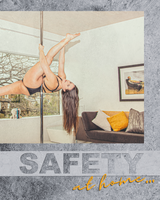
Welcome to the world of pole fitness—a dynamic, empowering, and exhilarating way to stay fit, express yourself, and unlock new levels of physical and mental strength. As you embark on or continue your pole journey, it's crucial to prioritize safety to ensure a rewarding and injury-free experience. This ultimate guide covers essential safety tips, installation advice, and best practices for creating a safe pole practice environment at home.
Choosing the Right Equipment Quality Matters:
Invest in a high-quality pole from a reputable brand like X-POLE. Look for poles with robust safety certifications, high-quality materials, and positive reviews from the pole community.
Type of Pole:
Consider the type of pole that best suits your space and practice needs—static, spinning, or dual-function.
Each has its benefits, so choose based on your current level and goals.

Resist temptation and buy a genuine brand pole, not a copycat or fake.
To read more on thedangers of fake poles read here
Safe Installation Location, Location, Location:
Select a clear area with ample space around the pole. Ensure there are no obstructions that could cause injury if you fall or extend too far.
Ceiling Checks:
Before installation, verify the type of ceiling and the presence of a secure mounting point. Use a stud finder to locate joists or beams. Avoid installing the pole on unsupported or weak ceilings.
Follow Instructions:
Install your pole according to the manufacturer's guidelines. If unsure, consult with a professional to ensure it's securely fitted. Regularly check your pole for stability before each use.
Creating a Safe Practice Space Appropriate Flooring:
Use mats specifically designed for pole fitness to cushion falls and provide a safe landing. Avoid practicing on hard or slippery surfaces.
Personal Gear:
Wear attire that maximizes grip on the pole while protecting your skin. Consider grip aids for your hands if you find yourself slipping often. Only use a moisturiser designedfor Polers eg Pole Physics
Warm-Up and Cool-Down Essential Routines:
Begin each session with a thorough warm-up to prepare your muscles and joints, reducing the risk of injury. End with a cool-down to help your body recover and prevent muscle soreness. Don't forget to stretch...
Learning and Progressing Safely Start Slow: Begin with foundational moves and gradually progress to more advanced techniques. Trying to advance too quickly can lead to injuries.
Use Spotting:
When trying new or challenging moves, have a spotter present. A spotter can provide physical support and guidance, ensuring your safety. This can be a strong friend or your pole teacher, but it can also be a strong resistance band if you are learning to invert.
Listen to Your Body:
Pay attention to what your body tells you.
If you feel pain or discomfort, stop and rest. Pushing through pain can lead to serious injury.
Celebrate your achievements & enjoy building your skills slowly.
Joining the Community Support and Advice:
The pole community is incredibly supportive. Join forums, social media groups, or local classes to share experiences, get advice, and find encouragement. Ask allll the questions in these groups. Don't be shy. It's the best place to research and get support.
Pole fitness at home can be a safe, enjoyable, and fulfilling activity when you prioritize safety and use the proper equipment. By following these tips and best practices, you'll create a secure environment that supports your pole journey, allowing you to explore your potential safely and confidently. Remember, safety is not just about preventing injuries; it's about ensuring a long, healthy, and enjoyable pole fitness journey.

